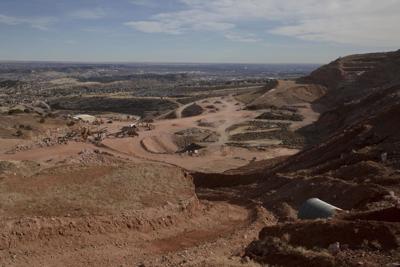A state regulatory board approved a new reclamation plan for Pikeview Quarry on Wednesday, clearing the way for a multimillion-dollar open space deal with the city of Colorado Springs that critics say could bring safety risks and hidden costs.
The Colorado Mined Land Reclamation Board unanimously approved Castle Concrete’s new plan to fill in the highly visible quarry on the northwest edge of Colorado Springs from the bottom up rather than removing heavy material from the top to fill, saying the approach would fulfill minimum state requirements. The board was also swayed because Division of Reclamation, Mining and Safety officials recommended approval of the new plan and reviewed costs of reclamation.
Several board members expressed reservations about the reclamation plan because Castle Concrete representatives were never clear on where the material to fill in quarry would come from.
“I will go along with the division, but with reservations,” board member Karin Utterback-Normann said.
Board member John Singletary supported the new plan, but noted that Castle Concrete’s parent company Continental Materials does not have a solid reclamation track record in Colorado Springs and citizens had to step in to finish the Queen’s Canyon Quarry reclamation.
The plan approval allows the city of Colorado Springs contract with Castle Concrete and long-term plans for a bike park to move forward. The city is buying about 340 acres in open space from the company for $8.9 million to help fund reclamation. As part of the contract, the city may also accept Pikeview Quarry as a donation when reclamation is complete and turn it into a bike park.
However, it could be years before a bike park opens, if the quarry is ever stabilized enough to be suitable for recreation.
The dirt work needed for reclamation would take about two years and the revegetation would require several more years, company representatives said. Once complete, it will be stable and safe, Castle Concrete president Jerry Schnabel said.
“I think it’s good for all parties involved,” he said.
The state accepted Castle Concrete’s proposal after hearing from experts hired by Colorado Springs resident Warren Dean who raised concerns around cost and safety.
The previous reclamation plan would have created shallower and inherently safer slopes that would be easier to maintain and revegetate, said Carl Mount, a reclamation expert retained by Dean who previously worked for the state’s Division of Reclamation, Mining and Safety.
The new plan also doesn’t remove heavy material at the top of the quarry and that could be dangerous, he said.
“If you approve it and it comes down when someone is using the site for recreation, it could kill somebody,” he said.
Schnabel said the new plan is safer because it doesn’t require workers to relocate material from the top of the quarry to bottom which could be dangerous for heavy equipment operators. The new plan also leaves far less of the high rocky walls exposed, said Paul Kos, geological engineer representing the company
Opponents of the plan questioned the quality of the material that has already been used to fill a hole below the quarry 110 feet deep, which will become the foundation for the material intended to hold the quarry in place. The objectors showed a photo of donated fill material that included old curb and gutter materials instead of proper materials.
“The toe of the hole is going to fail, the wall will fail,” said lawyer Steve Mulliken, representing Dean.
The company said the photo was misleading and that was not material wasn’t used as fill. The company has been accepting donated fill material and will continue accept it, but would not allow any trash to be used, Kos said.
State officials expect the reclamation could cost about $13 million if the company uses fill material from around the quarry. However, if only rocks and dirt from the site was used that would create a larger scar, said Michael Cunningham, a senior environmental protection specialist for the state.
Purchasing fill dirt and other costs not factored in by Castle Concrete could bring the total reclamation cost of the property to $30 million, on the low end, said Dan Bare, an engineer with Matrix Design Group hired by Dean.
Since the state requires the company to post a bond to cover the cost of the reclamation project should the company declare bankruptcy, he warned the state board the bond could come up significantly short, Bare said.
The state board said they trusted in estimates of their own officials.








(0) comments
Welcome to the discussion.
Log In
Keep it Clean. Please avoid obscene, vulgar, lewd, racist or sexually-oriented language.
PLEASE TURN OFF YOUR CAPS LOCK.
Don't Threaten. Threats of harming another person will not be tolerated.
Be Truthful. Don't knowingly lie about anyone or anything.
Be Nice. No racism, sexism or any sort of -ism that is degrading to another person.
Be Proactive. Use the 'Report' link on each comment to let us know of abusive posts.
Share with Us. We'd love to hear eyewitness accounts, the history behind an article.